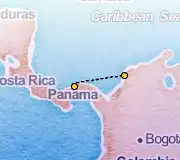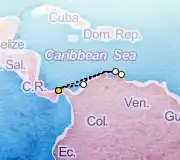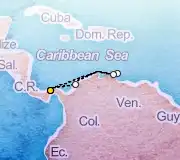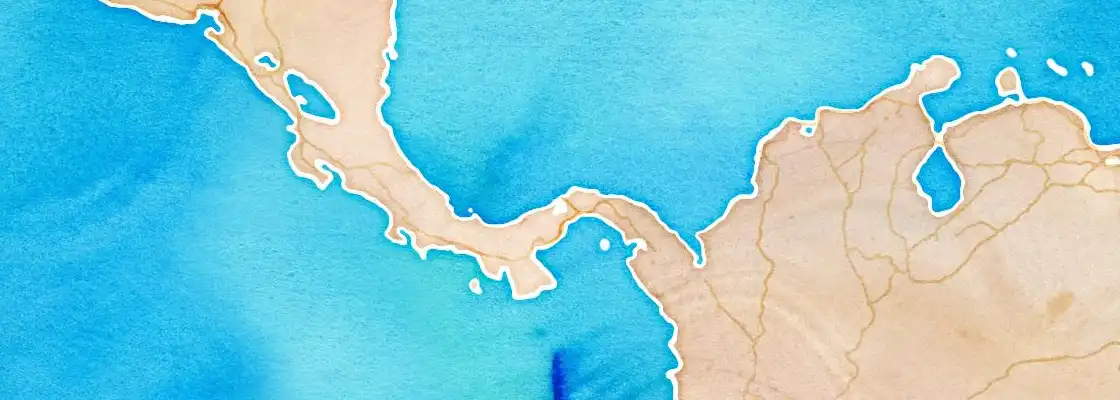Colón is a major seaport located on the Caribbean coast of Panama, strategically positioned at the Atlantic entrance to the Panama Canal. It serves as one of the country's most important commercial hubs and is home to the Colón Free Trade Zone, the largest in the Americas.
For cruise passengers, Colón is a primary gateway to experience the wonders of the Panama Canal and the rich history and biodiversity of the region. The port provides access to a wide range of shore excursions, from viewing the massive Gatun Locks to exploring historic Spanish forts and lush rainforests. Its significance lies in its direct connection to one of the world's greatest engineering achievements.
The most popular attraction is the Gatun Locks visitor center, located just a short drive from the port. Here, visitors can watch massive ships being raised and lowered 85 feet to and from the Caribbean Sea. The multi-level observation deck provides excellent views of this engineering marvel in action.
A visit to the UNESCO World Heritage site of Portobelo is a journey back to the era of Spanish conquistadors and pirates. Located about 45 minutes from Colón, this historic town features several colonial forts and a restored customs house.
Another significant historical site is Fort San Lorenzo, the ruins of a Spanish fort perched on a cliff overlooking the Chagres River. Also a UNESCO site, it offers dramatic views and is often part of a tour that includes the Gatun Locks. For a cultural experience, many tours offer a visit to an Embera indigenous village, providing insight into the traditions and lifestyle of the Embera people.
Last updated on June 20, 2025
Many cruise passengers take a day trip to Panama City, located about 77 kilometers (48 miles) south of Colón. The journey by road or the scenic Panama Canal Railway takes approximately 1 to 1.5 hours. Visitors can explore the historic Casco Viejo district and see the Miraflores Locks on the Pacific side of the canal.
The massive, man-made Gatun Lake is a popular destination for eco-tours and wildlife viewing. Boat excursions on the lake, which is a major part of the canal system, offer chances to see monkeys, sloths, and a variety of tropical birds. These tours are often combined with visits to the Gatun Locks.
Last updated on June 20, 2025
Cruise ships in Colón typically dock at the Colón 2000 terminal. This modern terminal is located on the Caribbean Sea at the Atlantic entrance to the Panama Canal. Ships dock directly at the pier, so no tendering is required.
The terminal itself is part of a larger complex that includes a hotel, a casino, and a shopping mall with numerous stores, restaurants, and duty-free shops. While the immediate port area is self-contained and safe for walking, it is not within walking distance of other city attractions. The main city of Colón is adjacent to the port, but transportation is required and recommended for any exploration beyond the secure terminal area.
Last updated on June 20, 2025
The official currency of Panama is the Panamanian Balboa (PAB). However, the currency is pegged to the US Dollar at a 1:1 ratio, and the US Dollar is used as legal tender for all paper currency.
Cruise passengers do not need to exchange money, as US Dollars are accepted everywhere. Credit cards are widely accepted in the cruise terminal, major hotels, and larger stores, but it is wise to carry small bills for taxis or small purchases. ATMs are readily available within the Colón 2000 port complex and dispense US Dollars.
Last updated on June 20, 2025
The city of Colón, outside of the secure port area, has a reputation for high crime rates. It is strongly recommended that cruise passengers do not venture into the city on their own. Independent walking tours are not advised.
For safety, visitors should remain within the Colón 2000 cruise terminal complex or participate in organized shore excursions arranged through the cruise line or reputable local operators. If you must take a taxi, use licensed vehicles dispatched from inside the secure port area and agree on the fare beforehand. As with any travel destination, avoid displaying expensive jewelry or large amounts of cash.
Last updated on June 20, 2025
Colón has a hot and humid tropical climate year-round. Average daily temperatures typically range from 24°C to 32°C (75°F to 90°F). The year is divided into two main seasons: a drier season from December to April and a rainy season from May to November.
During the rainy season, which coincides with part of the cruise season, rainfall is common but often occurs in short, intense afternoon downpours rather than all-day rain. Visitors should pack lightweight clothing, sunscreen, sunglasses, and a hat. It is also wise to bring a raincoat or umbrella, especially during the wetter months. Panama is located south of the principal hurricane belt and is rarely directly impacted by major storms.
Last updated on June 20, 2025
The most common and recommended transportation option for cruise passengers is to use licensed taxis or pre-booked shore excursions. Taxis are readily available at the cruise terminal; always agree on a fare before beginning your trip as meters are not typically used.
For a scenic and historic journey to Panama City, the Panama Canal Railway offers a unique experience along the canal. Public buses, known locally as 'diablos rojos', are not recommended for tourists due to safety concerns and navigational difficulty. Ride-sharing services are not reliably available in the Colón area for tourists.
Last updated on June 20, 2025
The best and most convenient shopping for cruise passengers is located directly at the Colón 2000 port complex. This area features a variety of duty-free shops, souvenir stores, and boutiques selling clothing, jewelry, and liquor.
The famous Colón Free Trade Zone is nearby, but it is primarily a wholesale commercial zone and is not set up for individual tourist shopping. For authentic local souvenirs, look for 'molas,' which are colorful textile art panels made by the Guna people, or hand-woven baskets. While some haggling may be possible with street vendors outside the port, prices in the terminal shops are generally fixed.
Last updated on June 20, 2025






Showing 1 ship in the area
No ships scheduled in port today.
Last updated on June 13, 2025
Taxis are readily available at the Colon 2000 cruise terminal and are the most common way to reach attractions. Some shops and restaurants are within the terminal complex itself.
Key attractions include the Gatun Locks of the Panama Canal (a short taxi ride) and the Colon Free Zone for shopping. The historic city center is nearby but explore with caution or on a guided tour.
Within the Colon 2000 complex, you'll find restaurants offering international cuisine and some local seafood dishes. For more authentic Panamanian food, you might need to explore further with local guidance.
The local currency is Panamanian Balboa (1 USD = 1.00 PAB). The US dollar is officially used alongside the Panamanian Balboa (PAB), so there's no need to exchange USD if you have it. ATMs dispensing US dollars are available at the cruise terminal and in the city.
Colon has a hot and humid tropical climate year-round; expect rain, especially from May to December. Pack light clothing, rain gear, sunscreen, and insect repellent.
Nearby beaches like Playa La Angosta or those on Isla Grande require a taxi ride (30-60 minutes), sometimes followed by a short boat trip. They offer a Caribbean coastal experience.
Popular shore excursions focus on the Panama Canal (Gatun Locks), rainforest tours, or visits to Embera indigenous villages. Booking through the cruise line offers convenience, while independent tours can offer more tailored experiences if well-researched.
The Colon Free Zone offers extensive duty-free shopping (passport required for purchases). Souvenirs include Panama hats, molas (textile art), and local coffee, available in the terminal or Free Zone.
The historic town of Portobelo, a UNESCO site, is about an hour away by taxi. The Panama Canal's Gatun Locks Visitor Center is also a major nearby attraction.
Colon is home to the Colon Free Zone, the largest free-trade zone in the Americas and the second-largest in the world.
Prices are about steady throughout the year. On average Colon is extremely inexpensive compared to other ports. The diagram below shows the monthly average cost per day for cruises from Colon.
Want to hear about the best deals and cruise tips every week? Sign up for our free weekly VIP Newsletter, customized exactly to your preferences!